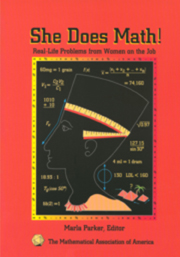Book contents
- Frontmatter
- Preface
- Contents
- Problems by Subject
- Environmental Psychology
- Software Engineering; Computer Science
- Archaeology
- Mathematics and Computer Science
- Civil Engineering
- Mathematics
- Electrical Engineering
- Physics; X-ray Astronomy Research
- Mathematics
- Physics; Astronaut Crew Training Instructor
- Business Data Processing
- Software Engineering; Real Estate Investment
- Quality Engineering
- Health Science
- Nursing Education
- Electrical Engineering; Space Systems
- Oil and Gas Accounting
- Business Administration Higher Education
- Aerospace Engineering
- Structural Engineering
- Computer Science
- Mathematics
- Dietetics—Foodservice Management and Nutrition
- Electrical Engineering
- Chemical Engineering, retired
- Software Engineering
- Immunology and Microbiology
- Mechanical Engineering
- HMO Pharmacy Practice and Management
- Ophthalmology
- Electrical Engineering
- Fish Pathology
- Computer Science and Computer Graphics
- Mathematics and Computing
- Electrical Engineering
- Astronomy
- Author
- Mathematics
- Reflections on WAM
- Solutions
Immunology and Microbiology
- Frontmatter
- Preface
- Contents
- Problems by Subject
- Environmental Psychology
- Software Engineering; Computer Science
- Archaeology
- Mathematics and Computer Science
- Civil Engineering
- Mathematics
- Electrical Engineering
- Physics; X-ray Astronomy Research
- Mathematics
- Physics; Astronaut Crew Training Instructor
- Business Data Processing
- Software Engineering; Real Estate Investment
- Quality Engineering
- Health Science
- Nursing Education
- Electrical Engineering; Space Systems
- Oil and Gas Accounting
- Business Administration Higher Education
- Aerospace Engineering
- Structural Engineering
- Computer Science
- Mathematics
- Dietetics—Foodservice Management and Nutrition
- Electrical Engineering
- Chemical Engineering, retired
- Software Engineering
- Immunology and Microbiology
- Mechanical Engineering
- HMO Pharmacy Practice and Management
- Ophthalmology
- Electrical Engineering
- Fish Pathology
- Computer Science and Computer Graphics
- Mathematics and Computing
- Electrical Engineering
- Astronomy
- Author
- Mathematics
- Reflections on WAM
- Solutions
Summary
I attended a three-year junior high school in a small town. Then I went to a very small rural high school for two years. There were only 200 students so class sizes were small. One math class had only six students. Most days were spent working at the blackboard, so we really learned to think on our feet! For as long as I was in school, I studied math—basic algebra, plane and solid geometry, trigonometry, matrix algebra, and analytic geometry.
At UC, San Diego, I earned a BA in Biology. While there, I took three courses of calculus and one course of statistics, and worked in a variety of jobs. As an undergraduate and between research positions, I worked as a bookkeeper. Good math skills helped me get those jobs, and they certainly paid better than the usual student employment. Bookkeeping was okay and I learned useful skills, but it was not nearly as fun as working in a lab.
I also worked in immunology research in cancer research and cellular immunology at the University and at the VA Hospital in San Diego. My bookkeeping skills were valuable when I was working as a lab supervisor, because I was responsible for budget management and developing budget estimates for grant funding. Math was also needed for scientific calculations and statistical analysis. Later, I was co-owner of a business making antibodies for diagnostic and research use, and served as a consultant to other companies involved in antibody production.
- Type
- Chapter
- Information
- She Does Math!Real-Life Problems from Women on the Job, pp. 111 - 115Publisher: Mathematical Association of AmericaPrint publication year: 1995



